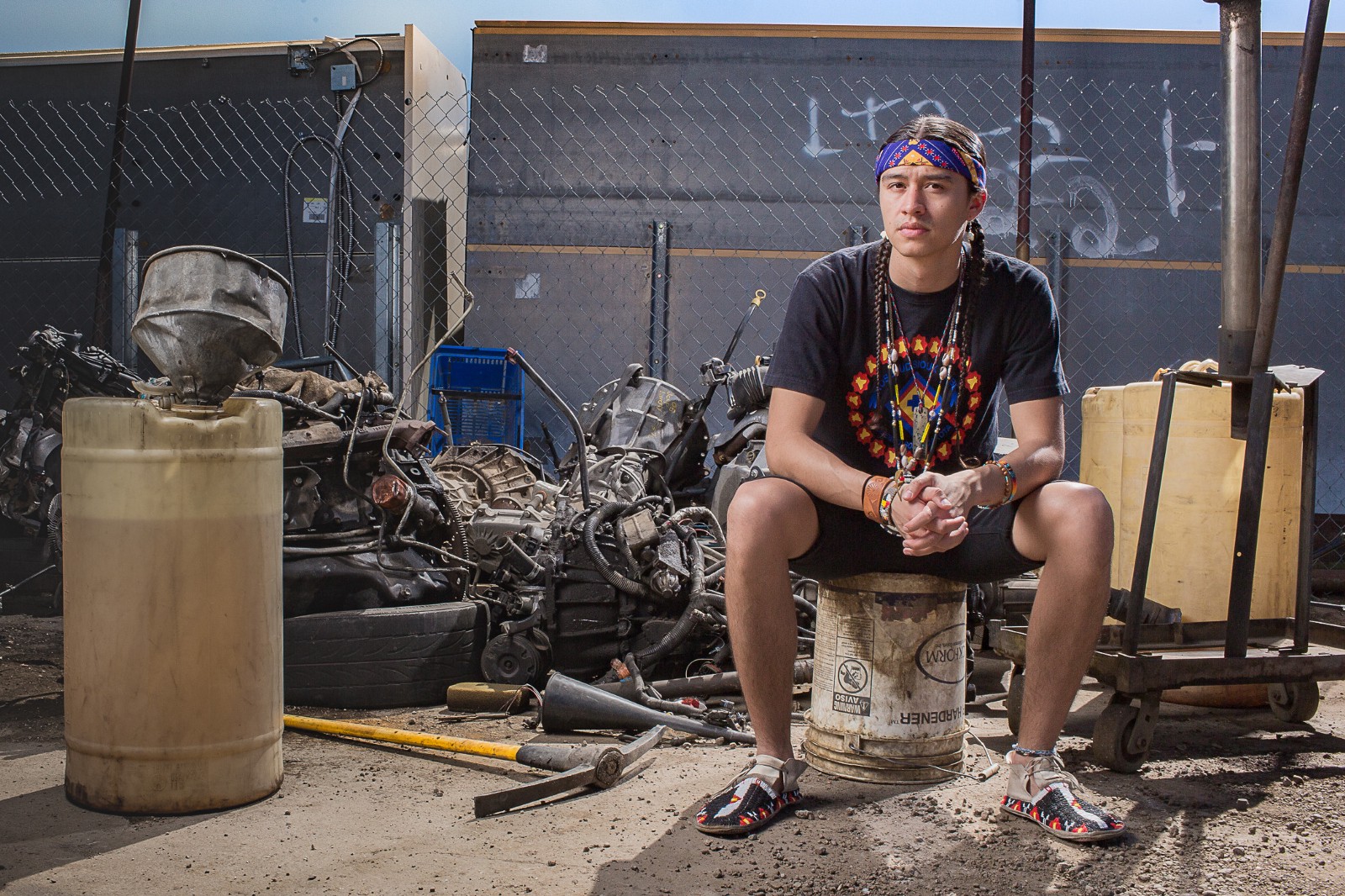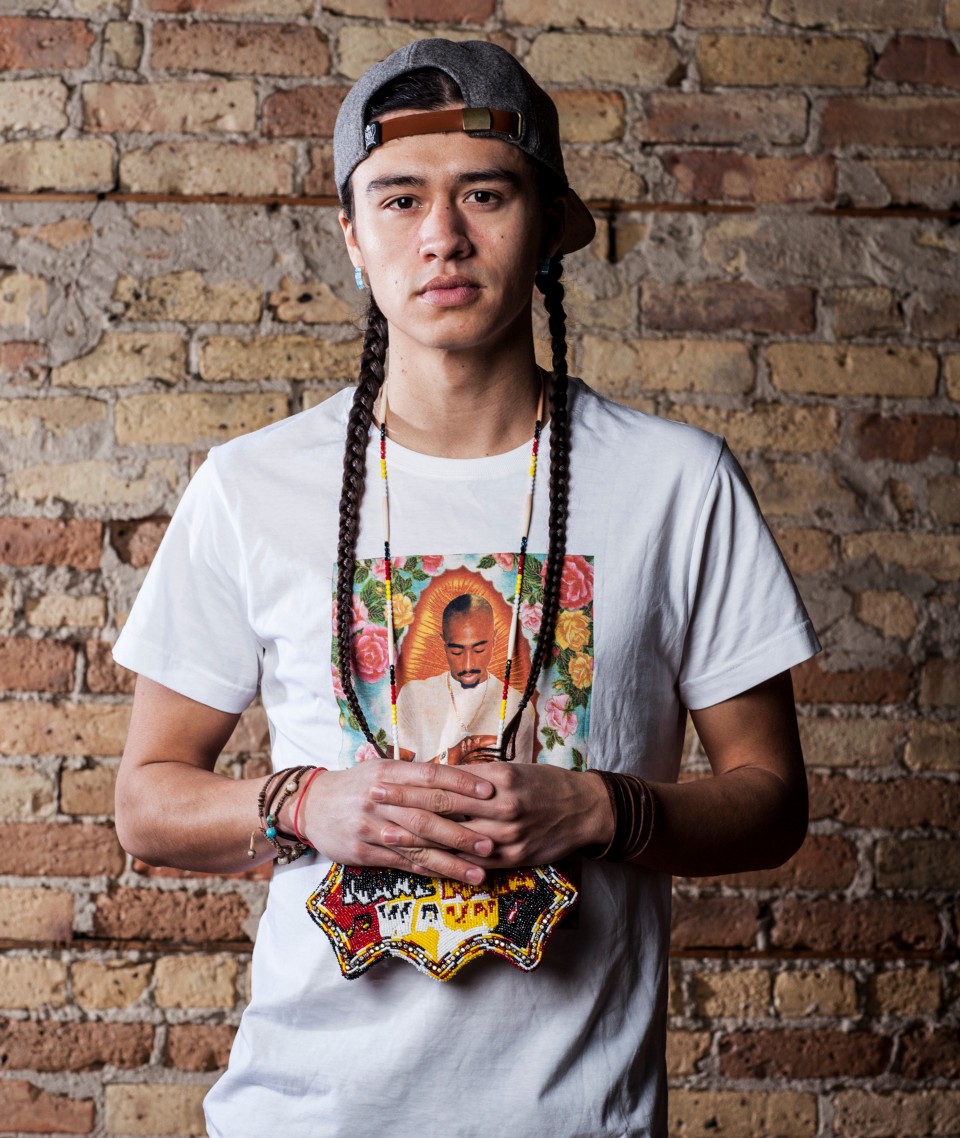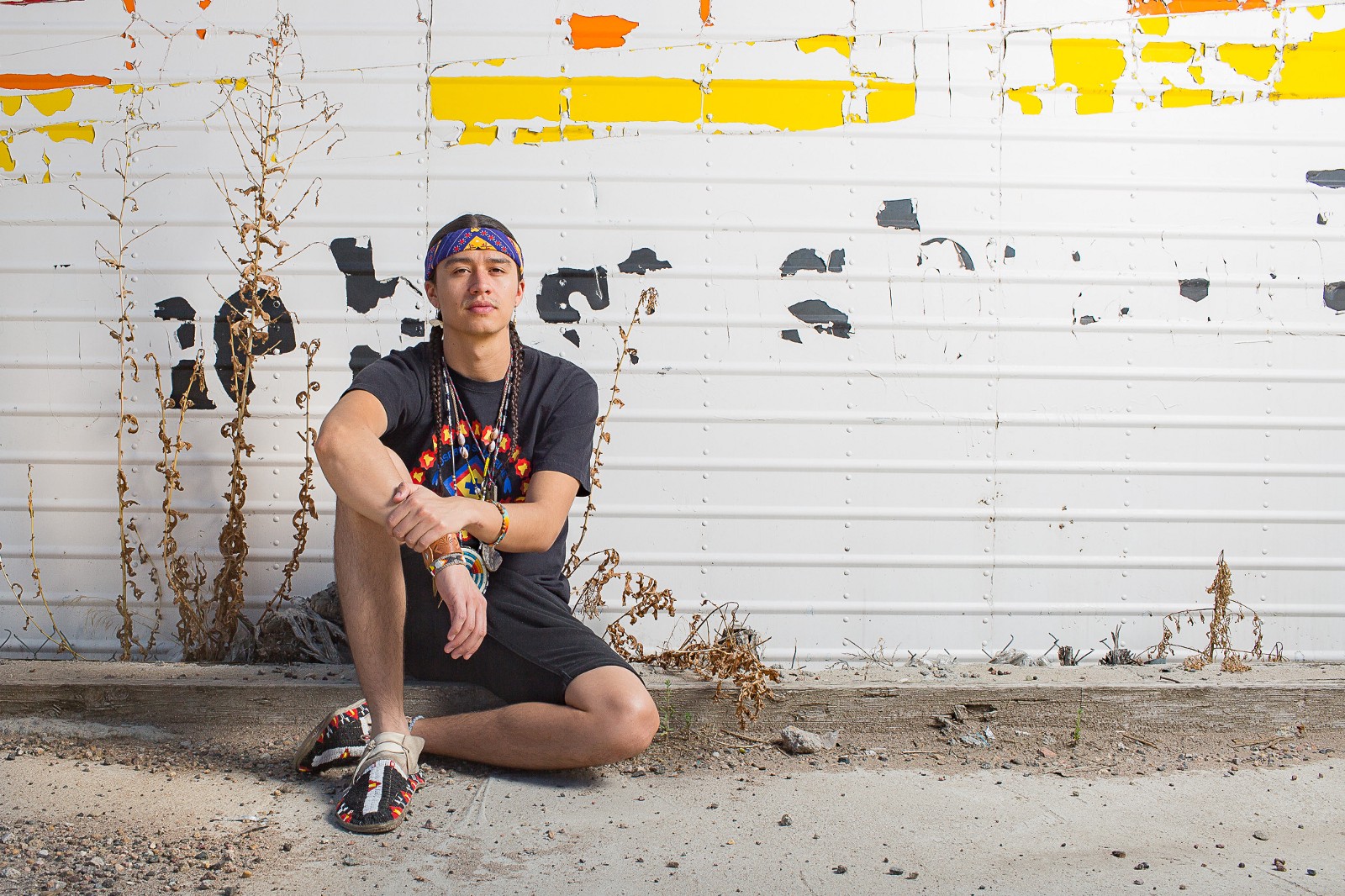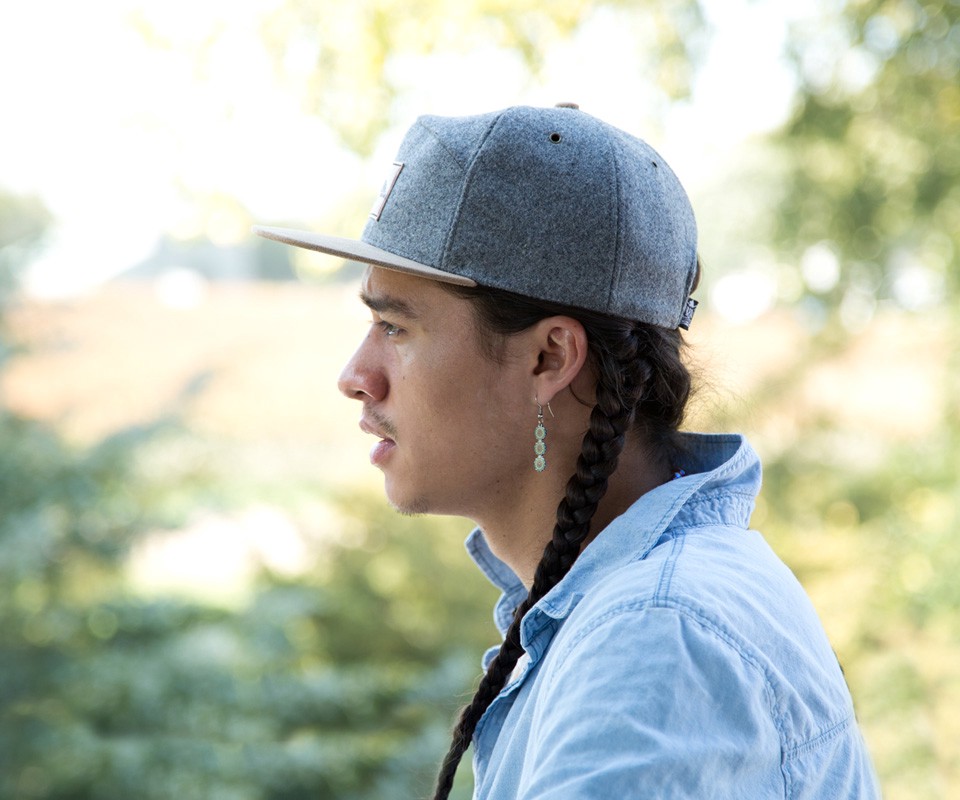
(Photo: Tomas Karmelo Amaya)
A young man walks onto an empty stage. The spotlight glares off of his white moccasins and crisp long-sleeved button-down, which billows, untucked, over dark slacks. He cuts a slight figure against the venue’s deep, black backdrop, and his clean-shaven face, framed by two long black braids, makes him look younger than his 27 years. He speaks softly into the microphone, first in his native Lakota, then in English: “Hello, relatives. My Lakota name is Walks With Young People. I also go by Frank Waln. And I welcome you with an open heart and an open handshake.”
Beyond the stage lights, in the darkened auditorium of the National Hispanic Cultural Center in Albuquerque, New Mexico, sit about a hundred Native American men and women from all over the country: Pueblo, Shoshone, Cheyenne, Choctaw, Cherokee, and Apache. The Gathering of Nations, an annual meeting of more than 500 tribes, is taking place across town, and many have broken away from the pow-wow to attend this concert, the culmination of the Rezilience (“rez” referring to reservation) Indigenous Arts Experience. Throughout the festival, visitors have attended events centered on Native art, poetry recitals, and traditional music, most of which celebrate the Native cultures and mourn their hastening disappearance.
Waln, the headliner, is something different. After his introduction, he is joined by the Sampson Bros., Sam and Micco, performance artists whose faces are painted colorfully beneath full and uttering Native dance regalia. Waln bends to his laptop, triggering a barrage of hip-hop beats that blasts across the venue. As the Sampsons dance to the music, the diminutive Waln springs into action, grabbing the mic from its stand and spitting lyrics at the crowd. Pain and anger are palpable in his voice as he bobs and weaves and hacks at the air with his free hand, fighting some unseen onstage foe.
The enemy is ignorance, which reveals itself plainly in Waln’s new song “What Makes the Red Man Red,” his send-up of the racist tune “What Made the Red Man Red” from Disney’s 1953 film Peter Pan. Waln’s song samples the tune’s chorus and the film’s offhand references to Native Americans as “aborigines” and “Indians.” That is, before Waln drowns them out with a sharp verse.
Your history books (lies)
Your holidays (lies)
Thanksgiving lies and Columbus Day
Tell me why I know more than the teacher
Tell me why I know more than the preacher
Tell me why you think the red man is red
Stained with the blood from the land you bled
Tell me why you think the red man is dead
The crowd is on its feet now, some singing along, others bobbing in agreement with the beat. Waln’s frequent tours of reservations and his blunt, firebrand style have made him well-known among his people (he’s a two-time Native American Music Award winner). Recently, Waln has made a splash in the mainstream media too: He’s been featured on NPR and MTV’s Rebel Music: Native Americaand in Vibe and USA Today; he has performed at the South by Southwest festival in Austin, and at concerts in France and Germany. The day before his Albuquerque concert, he spoke at a Harvard University symposium on Native politics.
The crowd is on its feet now, some singing along, others bobbing in agreement with the beat.
Waln is an ascendant member of a Native American hip-hop vanguard that is taking its message of social justice off of the reservation. What separates Waln and other socially engaged artists, like War Party, Without Rezervation, and Supaman, from older generations of Native artists, says Alan Lechusza Aquallo, a professor of American Indian studies at Palomar College, is their authenticity. Waln doesn’t play to Native stereotypes, like a preaching elder or a fierce sports mascot — his performing persona is young, charismatic, believably real. “There are a number of Native hip-hop artists who play off the kitsch of what it is to be Indian because that’s what’s going to give them notoriety,” Aquallo says. “[Waln] has his long braids, but he’s wearing street clothes. He’s not playing Indian.”
Waln’s activism is similarly more than mere posture. As Aquallo points out, Waln “walks the walk,” not only rapping passionately about depression and poverty on the reservation, but also demonstrating against the Keystone XL pipeline in Washington and speaking to students in high schools and elementary schools on reservations across the country. “He’s not an ‘Indian artist’; he’s not a rapper who happens to be Native,” Aquallo says. “To him there’s no separation between his activism and his creative work.”
Waln’s overall message is plain: Americans — Native and non-Native alike — need to educate themselves about the real history and current politics of America’s indigenous people. And through his words and music, on the reservation and off, Waln plans on delivering the wake-up call.
Frank Waln’s own education began on the Rosebud Sioux Indian Reservation, on the Great Plains of central South Dakota. He grew up in He Dog, a small Sicangu Lakota community, where his single mom and her sisters ran the family ranch. His father was abusive and mostly absent — the first of many scars he would learn to bear.

(Photo: Tomas Karmelo Amaya)
He Dog is located in Todd County, where the poverty rate approaches 50 percent, a problem with deep and tangled roots. Studies of modern Native Americans have shown that “historical trauma,” the name that social workers give to the perception of historical loss passed down through generations, has been linked to symptoms of emotional distress like anger, anxiety, substance abuse, and even depression. Waln remembers grappling with these manifestations even as a child. “It was very confusing to me,” he says. “I was wondering why I was struggling with depression all the time, why I had suicidal thoughts, why the suicide rate was so high on our reservation. I was very insecure.”
Being exposed to pop-culture caricatures of his people — red-skinned, unsophisticated, and uncivilized — didn’t help. “What society and the media told me about myself was that being Native American is something to be ashamed of,” he says. “That who we are as a people is wrong, savage. Not to say I believed that, but that did affect my self-esteem.”
Waln says his confusion stemmed from the fact that, beyond the traditions passed down through his family, he didn’t know much about the political history of his people. And indeed, with scant resources, schools on American reservations have fallen behind. A 2011 National Indian Education Study found huge deficits in reading and math scores for schools heavily attended by Native American students. Schools controlled by the Bureau of Indian Education, which are run by tribes, fared even worse: Fourth graders’ reading scores averaged 182 on a 500-point scale, compared to 204 in public schools. Only 43 percent of eighth-graders said that their teachers included any Native American culture or history in their curricula.
Outside the reservation, the Native historical narrative is even more distorted. Today, many schools still reflexively honor Columbus Day’s namesake as a brave trailblazer, rather than the man who ushered in a period of slaughter and displacement of the indigenous people he “discovered” along with the New World. A recent study of elementary- and secondary-school academic standards in all 50 states found that nearly 87 percent of those standards’ references to Native Americans harken back to events that occurred prior to the 20th century — essentially conveying the idea that Native Americans ceased to exist after 1900. None of the references said anything about current issues that are facing 566 federally recognized tribes — such as land use, voting rights, religious rights, and Internet access.

(Photo: Tomas Karmelo Amaya)
“In my opinion, the way history is taught in this country is colonial propaganda,” Waln says. “I was aware of the big atrocities, like the Wounded Knee Massacre and the government giving us blankets with smallpox. But I didn’t know the details and how recent some of these discriminatory laws were.”
If Waln didn’t see himself in textbooks growing up, he did in music. He learned piano at age seven; he joined a Lakota drum group in middle school. When Waln was a teenager, his older cousins started gathering in their basements to make music, influenced by rappers like Nas, Talib Kweli, Dead Prez, and Eminem. Waln started sampling beats and recording on his laptop. To his mother and most of the adults in his cowboy-and-rodeo community, Waln’s sudden infatuation with hip-hop could be attributed to hip-hop’s popularity with kids his age. But to Waln, his playlist wasn’t just about youth culture. “A lot of Native Americans are living in poverty,” he says. “Hip-hop was born in poor communities of color.”
Still, Waln’s own music was his private solace — for his ears only. When he graduated high school in 2008 as valedictorian and was awarded a Gates Millennium Scholarship, he was too insecure to gamble his ticket off the reservation on a musical lark. He chose pre-med at Creighton University in Omaha. “I was the smartest kid in my class,” he says of the experience. “Now I was the dumbest kid in all of my classes.” He studied at all hours to keep up with his peers, used his laptop solely for class, and in two years didn’t finish a single song. Without an outlet connecting him with his past, he says, he fell back into depression. After his sophomore year, he came home and poured himself into his music. His mother supported his interest in going to school for it.

(Photo: Tomas Karmelo Amaya)
At Columbia College, a liberal-arts school in Chicago, Waln found his music’s public purpose. In a city pulsating with new sounds and emerging musicians, Waln met artists of color and even a few other Native Americans — including the Sampson brothers, who were learning to express their Seneca and Creek heritage through dance.
In Chicago, Waln says, he also encountered the vast ignorance of the outside world. He remembers that one girl in his dorm sincerely believed that Native Americans were extinct; other students were preoccupied with pettier problems than his. “I found that I had a higher tolerance for trauma,” Waln says. “My people survived genocide. That historical trauma is passed down through our DNA.”
With the encouragement of his teachers, Waln fused history into his music. By channeling his people’s anger and frustration through his lyrics, he was not only educating his classmates, he was also providing catharsis for himself. Through hip-hop, Waln was finally learning how to heal.
At the end of an intense and spirited first set, the Sampson Bros. clear the stage. Waln, silent, falls to his knees. An old man’s grizzled voice plays over the speakers, recounting the day in 1890 when more than 250 Lakota were slaughtered by the United States Cavalry on the Pine Ridge Reservation in South Dakota — the Wounded Knee Massacre. The first shot was fired when a deaf elder refused to surrender his legally obtained rifle. The dead included women and children. This is Waln’s song “Wild West.”
Waln is on all fours, eyes closed as the elder speaks. He raps the entire song from his knees, swaying back and forth like a bop bag. He’s talking about poverty and absentee parents and depression — the modern manifestations of his people’s inherited pain. As the track climaxes, he makes a gun with his fingers and brings it to the side of his head. The sound of a gunshot rings out; Waln collapses, rolling onto his back, leaving the audience in stunned silence.
The largely Native audience is no stranger to this pain, those ancestral wounds. But as Waln prepares to release his first solo album, Tokiya (Lakota for “firstborn”), there’s no reason to believe that this young Lakota can’t incorporate his people and their unique concerns into hip-hop’s ongoing conversation about America. Waln, like artists Kendrick Lamar and Run the Jewels, is making music that shakes its listeners awake to the troubled state of civil rights in this country. “They have a foot in each of the different worlds,” says Aquallo of Waln and Native contemporaries. “When they perform in non-Native venues, they’re performing who they are. It becomes important to the people they touch.”
Backstage after the show, Waln and the Sampsons are in the dressing room, unwinding in silence after an hour-long performance. It’s almost 1 a.m.
There’s a knock at the door. One of the night’s other performers, a singer- songwriter, comes in and immediately offers Waln a hug. She says she connected powerfully to Waln’s battle with depression, and thanks him. “Time is sure to break the stigma on mental illness in our people,” she says before she leaves. Waln peels off his moccasins and rubs his feet. He says he and the Sampsons will head over to his manager’s house to eat pizza. They plan on watching The Good Dinosaur — a children’s movie set in an alternate world where dinosaurs never became extinct.





